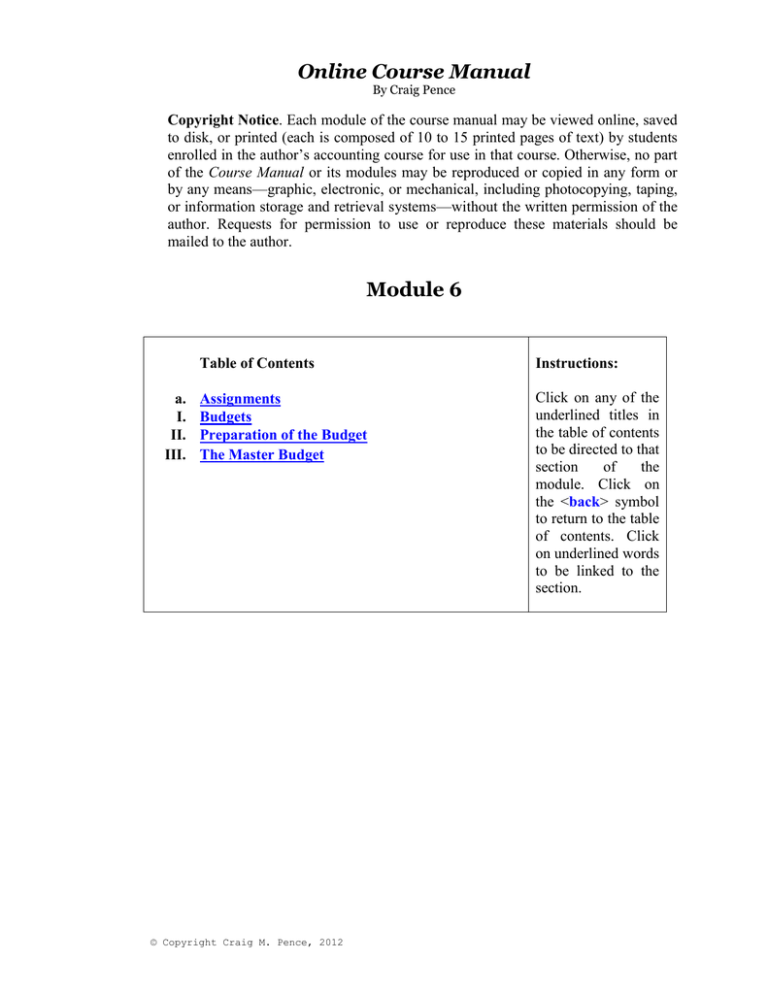
Online Course Manual
By Craig Pence
Copyright Notice. Each module of the course manual may be viewed online, saved
to disk, or printed (each is composed of 10 to 15 printed pages of text) by students
enrolled in the author’s accounting course for use in that course. Otherwise, no part
of the Course Manual or its modules may be reproduced or copied in any form or
by any means—graphic, electronic, or mechanical, including photocopying, taping,
or information storage and retrieval systems—without the written permission of the
author. Requests for permission to use or reproduce these materials should be
mailed to the author.
Module 6
a.
I.
II.
III.
Table of Contents
Instructions:
Assignments
Budgets
Preparation of the Budget
The Master Budget
Click on any of the
underlined titles in
the table of contents
to be directed to that
section
of
the
module. Click on
the <back> symbol
to return to the table
of contents. Click
on underlined words
to be linked to the
section.
© Copyright Craig M. Pence, 2012
Module 6 Summary
I.
Budgets are prepared by all types of organizations in order to (1) plan future
operations and (2) to control operations by establishing standards that can be
used to evaluate performance.
Instructor’s Lecture Notes: Recall the management functions listed in Module 1:
planning, directing, controlling, improving and deciding. Obviously, budgets, since
they represent planning and control devices, are an integral part of the management
process.
A.
B.
Budgeting formalizes the planning process, and forces managers to assess
the firm's future position realistically (i.e., to “think ahead”). Potential
problems are identified in advance of their occurrence so that they can be
avoided, if possible. Failure to do this results in the undesirable practice
of “management by crisis,” in which managers spend all their time
dealing with problems (“putting out fires”) that could have been avoided.
1.
Budgets are planning documents that may contain both financial
and nonfinancial data. Their primary objective relates to the
forecasting of future events. This means that the data they contain
are based upon estimates and projections. Despite the error that is
inherent in estimation, the goal is to provide accurate, meaningful
data to the users of the information the budgets contain.
2.
Budgets may be prepared in any format and may contain any
information that the company and its management finds useful.
The budget should contain enough information to meet managers'
needs but distracting, irrelevant information should be eliminated.
3.
Budgets are communication and coordination aids that force
managers to put their thoughts on paper and share them with
others in the organization. The budgeting process thus produces a
synthesis of individual perspectives and viewpoints, which results
in (1) a more realistic and accurate budget and (2) a
uncontrollable perspective regarding the organization’s objectives
and each manager’s role in achieving them. This encourages
teamwork and fosters a coordination of efforts between
departments and managers that might not exist otherwise.
Once the budget is establish, budgeted amounts represent benchmarks
against which future performance may be evaluated in order to control
business operations. The following module details the way in which
budget standards should be established and variances from them may be
analyzed.
1.
Responsibility accounting refers to the use of budget standards to
evaluate responsibility centers (individual managers, departments
or divisions).
© Copyright Craig M. Pence, 2012
Managerial Accounting Course Manual, Module 6
II.
3
2.
The major goal in responsibility accounting is to hold managers
responsible for only those factors the manager can control.
Performance reports must be prepared in accordance with this
principle.
3.
In the modern JIT production environment, operating
performance must be monitored closely making it necessary to
provide managers with continuously updated budget information.
<back>
Preparation of the Budget. In order to prepare a budget, the budget period
must be established and data must be gathered.
A.
B.
The budget period (the period of time the budget will cover) should be
long enough to give timely warning of future problems, but short enough
so that reasonably good estimates may be made.
1.
Period budgets are detailed operating budgets for a specific
period of time, usually one year or less. Long-term plans are
more general in nature since the detailed revenue and cost figures
that will occur so far in the future cannot be estimated with any
degree of confidence.
2.
Continuous budgets (also called perpetual budgets, or rolling
budgets) are cast for a period of time (say, 12 months), and then
are updated monthly (or quarterly). The idea is to add a new
month (or quarter) as one is ended, so that the budget always
covers the coming 12 month period.
Budgets may be “imposed” upon the organization by top management, or
they may be developed from the “bottom-up” by involving workers and
mid-managers in their construction. “Bottom-up” budgeting is called
participative budgeting, and the result is a self-imposed budget.
1.
The success of the budgeting process depends upon many
"people" factors and it is important that all persons at all levels in
the organization be involved in the budgeting process.
Participative budgeting is an important component of effective
budgeting. Standards are perceived as fair since the persons who
will be evaluated by them help establish them (“self-imposed”
standards); lower-level employees feel valued and important,
improving morale; and the budgets may be more realistic since
they are established by the people most closely in touch with dayto-day operations. When done well, the budgeting process
reduces goal conflicts (differences between the goals of
individual managers and the overall organization), motivates
employees to perform well, and provides management with a
reliable and useful strategic planning tool.
© Copyright Craig M. Pence, 2012
Managerial Accounting Course Manual, Module 6
4
2.
A budget committee must be established that can work
successfully between top management and lower-level
managers. The committee is responsible for coordinating the
process of communicating the long-range goals established by
top management to the parties who must establish short-term
plans, and passing feedback from lower-level management back
to top management. Clear and complete communication must
occur between all the parties involved in the budgeting process.
3.
Top management must actively support the participative
budgeting process. Employees must feel that top management
views budgeting as vitally important, and that budget standards
will be used as a problem identification tool and not an unfair
punishment mechanism.
4.
Good budgeting housekeeping principles must be followed in
exercising budgetary control over the organization. This requires
that (1) a realistic approach must be taken by all participants
when establishing the budget (it is tempting for managers to
“pad” their budgets by building in “slack” to protect themselves),
(2) deadlines must be met, and (3) since budget standards are
based upon what are sometimes very uncertain estimates,
flexibility must be applied when the budget is used to evaluate
performance.
5.
C.
Budget follow-up procedures should be carried out to identify
weaknesses in the budgeting process and to correct errors in the
estimates that make up the budget once they are identified.
<back>
Zero-Based Budgeting requires managers to “start from zero” when
preparing budgets, essentially justifying all expenditures on the
manager’s budget. This is in contrast to an incremental budgeting
approach, where the manager begins with last period’s budget and adds
to or subtracts from the amounts on it.
1.
Zero-based budgeting provides tighter control over
expenditures than incremental budgeting does, but also results in
much more administrative effort and cost.
2.
When it is used, it is often applied intermittently to reduce
cost. For example, the company may apply zero-based budgeting
every fifth year, utilizing an incremental approach in the other
four years.
©2012 Craig M. Pence. All rights reserved.
Managerial Accounting Course Manual, Module 6
D.
III.
5
The budget may be a static budget (a budget established for a single
expected level of activity) or a flexible budget (a budget that can be
easily restated for any level of activity). Flexible budgets make
performance assessment possible for any activity level attained during the
period. Static budgets are only useful in assessing performance if the
budgeted activity level is actually attained. Static budgets are generally
not used for performance evaluations because they distort budget
variances. For example, if a strike shuts down the plant for 2 weeks and
only half the units that were scheduled to be produced are actually
completed, should we be surprised to find that the actual production costs
are all well below the amounts listed on the static budget that was
prepared for twice as much production?
The Master Budget.
A.
The master budget is a set of schedules and other component budgets
that culminate in a forecasted income statement for the budget period and
a forecasted balance sheet as it will appear at the end of the budget
period.
B.
The master budget is composed of a sales budget, production budget,
materials purchases budget with a schedule of cash payments for
materials, direct labor budget, overhead cost budget, selling and
administrative expense budget, cash budget, capital expenditures
budget, the forecasted income statement and the forecasted balance
sheet.
C.
The processes involved in setting up the master budget is not illustrated
in this manual, and you are not responsible for being able to prepare all
the schedules and sub-budgets that make up the master budget. You
should, though, have a general understanding of the process. Please refer
to your text, which illustrates the development of the master budget in
detail.
<back>
-END-
© Copyright Craig M. Pence, 2012









